Ah…Tuscany, home to the famous historic towns of Florence and Siena, the cradle of the Renaissance. A land of rolling hills with olive groves and vines, beautiful art and architecture and delicious food and, of course, great wine. This Tuscany fast facts feature is intended to give you the low-down on those wines, the vineyards where the grapes are grown, how the wines are made and how to figure your way through the maze of different names on the labels.
Where is Tuscany anyway?
This is a hilly triangular-shaped region in central Italy tucked between the Apennine Mountains that are the spine of Italy to the east and the Ligurian and Tyrrhenian Seas (both part of the Mediterranean) to the west. To the north are the regions of Liguria and Emilia-Romagna, to the east is Marche and to the south are Umbria and Lazio.
The majority of Tuscany’s vineyards are in the hilly landscapes inland but plantations run down towards the Tuscan coast as well. Tuscany has a very long and rich viticultural heritage, planted with grapevines since the Etruscan civilisation.
Latitude and longitude
Florence: 43.7°N, 11.3°E
Altitude
The altitude of Tuscany is very varied: from sea level up to 700 m.a.s.l.
Climate and topography
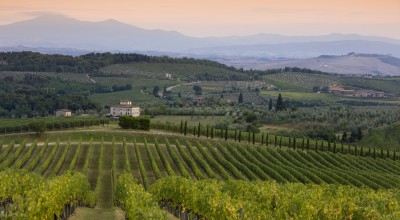 The climate here is Mediterranean with hot and sunny summers and mild autumns with rain in the winters.
The climate here is Mediterranean with hot and sunny summers and mild autumns with rain in the winters.
The climate is modified by proximity to the sea or altitude. So the southern coastal region of Maremma, where the land is closer to sea level, the temperatures are warmer than in the higher altitude inland vineyards of Chianti Clasico and Brunello, for instance.
As this is a mainly hilly area, exposure to the sun and the wind varies a lot, so temperatures can vary significantly between individual sites. This has an impact on the wine styles produced. For instance, the Chianti sub-region of Chianti Rufina is further inland, nestling in the foothills of the Apennines and some vineyards are higher than many others in Tuscany (up to 700 metres above sea level). There is also a pass-through which sea breezes blow in, cooling the vineyards. These conditions mean that while days are fairly warm, nights are cool, which slows down the ripening of the grapes. As a consequence, the very best Chianti Rufina wines have a higher acidity, enhanced aromatic expression and greater ageing potential than some other Chianti wines.
Average annual rainfall in Tuscany
Chianti: 867mm rain per year
Average temperature in summer in Tuscany
Approximately 23°C in Chianti
Average temperature in winter
Approximately 5°C in Chianti
Soils in Tuscany
This is a large region and soils vary. Montalcino and some parts of Chianti Classico have some friable marl-like soils called Galestro. Montepulciano has sand and heavy clay soils and San Gimignano has sandy soils, often over compacted clay.
Guide to Tuscany & its wine regions: Viticulture Facts
The trend across the region is to look for higher quality. This starts with the choice of rootstocks to suit the soil conditions and deciding which clone to use – particularly for Sangiovese. Planting densities are increasing in order to produce fewer, more concentrated grapes and therefore higher quality wines.
In this same quest for quality, many producers are reducing yields in a variety of ways, like green harvesting. As elsewhere around the world, viticulturists are looking to ensure their grapes reach the right level of ripeness and pick at the right time. So techniques include canopy management to ensure good exposure while avoiding sunburn, and both carrying out analytical tests and tasting the grapes regularly in order to determine the optimum harvest date.
[mepr-hide if=”rule: 2080″]
Want to continue reading to learn about:
- Vine training in Tuscany
- Pests and diseases in Tuscany
- Grape varieties in Tuscany
- A tasting guide and technical notes on the Sangiovese grape variety
- Feature on the history and context of the Super Tuscans and the Maremma coast
- Wine regions in Tuscany
- Wine styles and winemaking in Tuscany (including Vin Santo)
- Wine rules & appellations in Tuscany
and more?
This content is exclusive for Members. Take a look at the introductory packages below to become a Member of 80 Harvests and get unrestricted access to all our content. Thank you for supporting the journey and being part of the 80 Harvests community!
[mepr-group-price-boxes group_id=”2070″]
[/mepr-hide]
[mepr-show if=”rule: 2080″]
Vine training
The most common system for Sangiovese across Tuscany is single or double cordon spur, where a permanent branch is trained horizontally along a wire stretched between poles. This cordon produces fruit-bearing canes, which are trained in place for the season and then pruned back each year.
This system controls vigour, which is good for high quality. It is also good for mechanized pruning and harvesting. That said, the degree of the slope will have a bearing on whether fruit is manually or mechanically harvested. Quality also counts – in Brunello, most grapes are still manually harvested, though some other tasks like pruning are done mechanically.
Pests and diseases
Sangiovese is prone to oidium (powdery mildew). But the most devastating problem is a fungal disease called esca that attacks the wood of the vines, particularly older vines.
Grape varieties in Tuscany
Sangiovese is King in Tuscany, with two thirds of vineyard plantings focused on this red grape variety. The next most important grape varieties in terms of quantity and quality are Merlot and Cabernet Sauvignon. The most planted white grape is Trebbiano, although it is less renowned for quality, and makes up just over 5% of plantings.
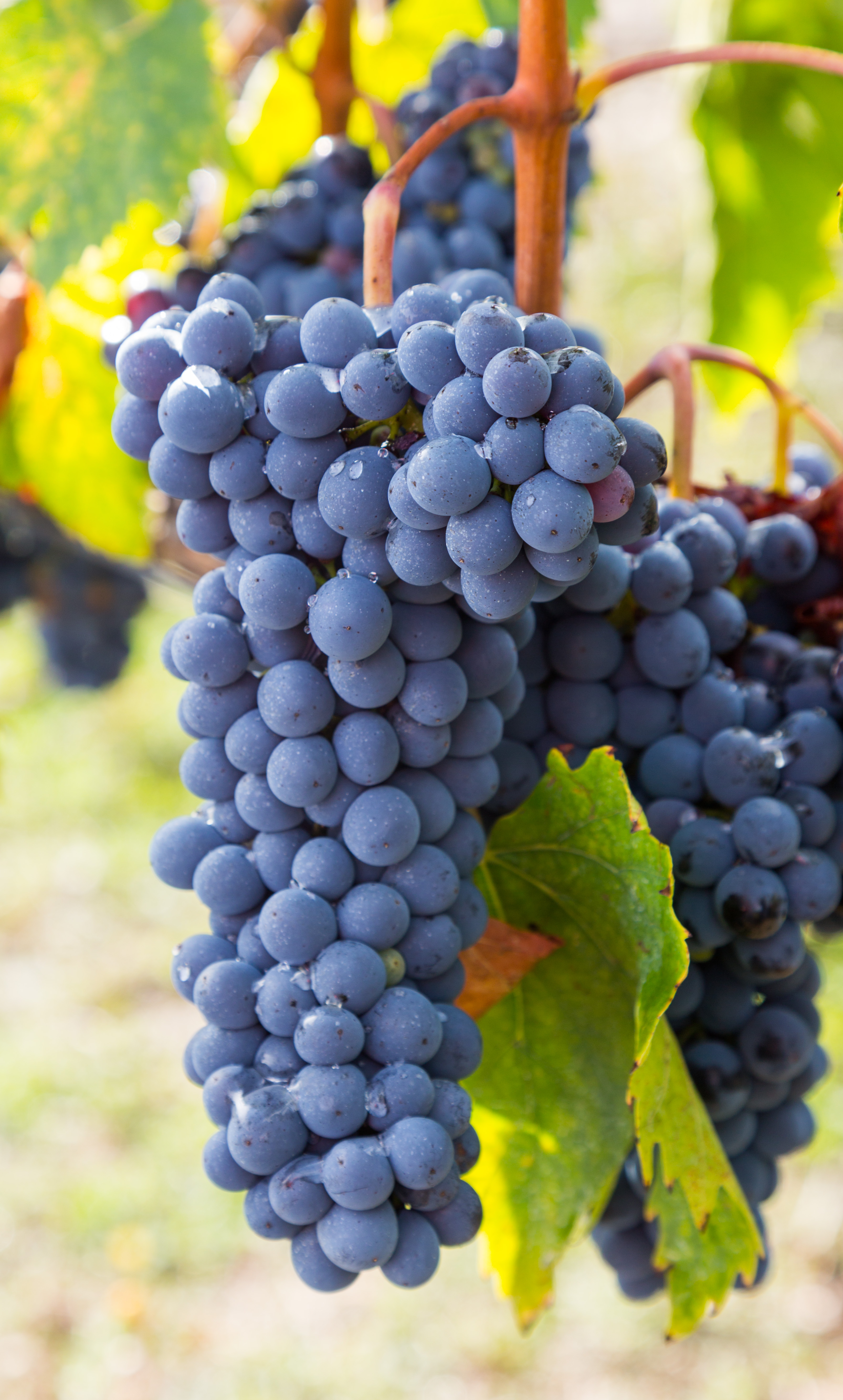
Photo credit: Consorzio del vino Brunello di Montalcino
Sangiovese – everything you ever wanted to know and then some
Sangiovese is Italy’s most planted grape variety and Tuscany is its heartland. This variety thrives here as nowhere else in the world and it forms at least part of many of the wines made here – even some of the sweet ones. Sangiovese is as genetically varied as Pinot Noir and therefore the yields, viticultural preferences and wine profile vary a lot too. A great deal of research has been carried out into the different clones and in recent decades many producers have replanted their vineyards with clones better suited to quality grape production and their particular growing conditions.
Again like Pinot Noir, Sangiovese is a pernickety grape variety that needs just the right climatic conditions to perform well. It’s an early budder but a late ripener and needs a warm growing season. Emilia-Romagna is the northernmost area of Italy with enough warmth to successfully ripen this variety. However, in conditions that are too warm – for instance to the south of Tuscany – its acidity can drop and alcohol can soar. In fact, it does best in areas where the climate is just warm enough for it to ripen, most especially the cooler parts of Tuscany. What is more, the grapes are thin-skinned, so that means they are susceptible to rot in damp weather.
Those thin skins mean the wine tends to be light to medium ruby, but this varies according to where they were grown and what clone was used and, if another, darker-coloured variety like Cabernet Sauvignon or Merlot has been added, then the colour can be deeper and the wine will have some of that variety’s aromas and flavours too. The aromas of Sangiovese can include red fruit like cherries, strawberries, raspberries, plums, along with floral notes like violets and savoury notes (tomato plants) and herbal notes. With age, the wine can take on notes of tea leaves, tobacco and leather. If new oak has been used, the wine is likely to reveal notes of that (vanilla, cloves, cedar). Oak (new or neutral) will also smooth the often quite pronounced tannins, making them feel rounder in the mouth. These days, the grapes are being picked a little later, when more fully ripe, to ensure riper, less astringent tannins.
The acidity of Sangiovese tends to be high. A poor Sangiovese wine can be thin and tart. A young, easy-drinking Sangiovese wine can be deliciously cherry-fresh and just made to enjoy with pizza or pasta. And a really serious, finely made Sangiovese can have lovely fresh acidity, balanced by firm tannins and medium body with medium to high alcohol, complemented by good fruit concentration. These wines can have good ageing potential (in some cases even decades).
Cabernet Sauvignon and Merlot
Well, these are among the world’s most planted red varieties, so it comes as no great surprise that they are planted here in Tuscany too. What was perhaps harder to predict – certainly back in the 1940s when the first small plot of Cabernet Sauvignon was planted in Bolgheri – is just how excellent some of the wines made with these Bordeaux grapes (often with a splash of Sangiovese) actually are.
Check out the story of the Super Tuscans and the Maremma coast in general below.
Trebbiano Toscana (also known as Ugni Blanc)
To understand why this neutral and rather boring white variety is among the world’s most planted, you have to look at what an easy-grower it is. It’s very high yielding and disease resistant, making it a real plus for anyone who wants a reliable vine that will produce high quantities of healthy, fairly acidic grapes to make large amounts of wine.
In France, Ugni Blanc is widely grown to make the base wine for Cognac and Armagnac, where the flavour of the wine is of far less importance to the taste than the distillation process and subsequent ageing. In Italy, there are over 22,000 hectares of the vine planted and mostly it is used as part of a blend. If made into a monovarietal wine, it is likely to be “light, crisp and wet”, as the Oxford Companion to Wine so articulately explains. Trebbiano Toscana is a permitted variety in many wines across Italy, including Chianti and Montepulciano. Generally, it is not considered to contribute anything special to the wine and its use is in decline now producers are looking to emphasize quality over quantity.
Vernaccia di San Gimignano
What a minefield grape names can be! This type of Vernaccia is thought not to be related to other grapes that go by the same name. This is grown in the area around the pretty town of San Gimignano in Siena in Tuscany and is made into pleasant dry white wines.
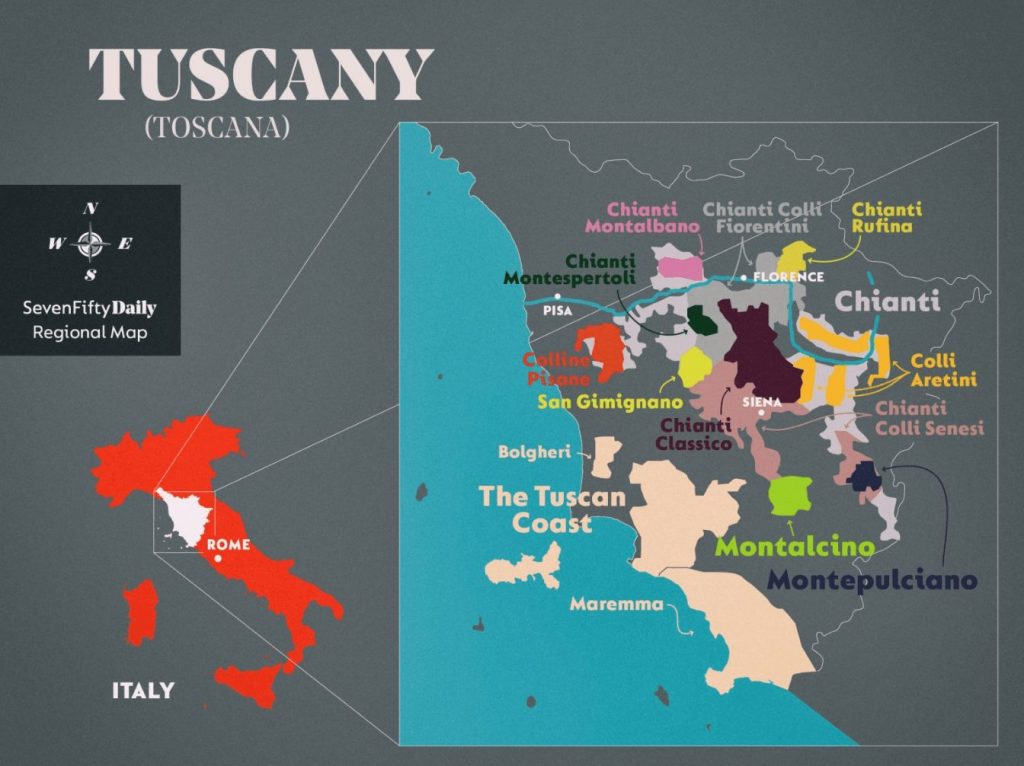
Map by Daily.SevenFifty
Winemaking and winemaking styles in Tuscany
Red wines in Tuscany
In a region as large and varied as Tuscany, it is hard to generalize. There are large-scale, industrial producers making simple, quaffable wines using selected yeast and temperature-controlled fermentation in stainless steel tanks followed by a brief ageing period and early release on the market. There are boutique wineries that have returned to the old ways of fermenting the must with ambient yeasts and ageing in the large neutral barrels known as Botti. And, of course, there is a whole range of wine producers, large and small, making a whole plethora of wines in different styles in between.
The general trend, however, is towards more careful use of oak and a greater emphasis on quality. Where the red wines are blended, this is done with care so that the additional contributions of e.g. Merlot or Cabernet Sauvignon do not overwhelm the Sangiovese. In fact, there are now many more 100% Sangiovese wines.
White wines in Tuscany
This is a real red wine region but it does produce a small amount of white. Vernaccia di San Gimignano is a crisp, dry wine that has enjoyed some success – more information in the section on San Gimignano below. There is also some Vermentino wine.
Vin Santo
Many parts of Italy have a long tradition of making sweet wines from sun- or air-dried grapes. Tuscany is especially known for its Vin Santo from white varieties and Occhio di Pernice, which is a sweet red wine made partly or wholly from Sangiovese.
Many different regions now have their own DOC rules for these wines. For instance, in Montalcino, the Vin Santo and Occhio di Pernice wines fall under the Sant’Antimo DOC. Both styles can also be made as Riserva. In Montepulciano, Vin Santo is made primarily from Malvasia Bianca, Grechetto Bianco and/or Trebbiano Toscano but up to 87 varieties are allowed, while the Occhio di Pernice is at least 50% Sangiovese. Meanwhile, Vin Santo from San Gimignano allows the use of a minimum 30% Trebbiano Toscano, a maximum 50% Malvasia del Chianti (aka Malvasia Bianca Lunga) and a maximum 20% Vernaccia di San Gimignano plus up to 10% of other white grape varieties, while its Occhio di Pernice must be made using at least 50% Sangiovese, the rest being any other variety in Tuscany.
The grapes are picked when ripe or sometimes they are picked much later when they have higher sugar and lower acidity. Once harvested, they are put into a well-ventilated, covered area to dry until at least December. During this process, they lose water and therefore the acidity, sugars and flavours become more concentrated. They are pressed and the thick, sticky juice is fermented. The fermentation can be stopped early to retain extra sugar or else it will stop when the alcohol level reaches a point where the yeast can no longer survive (around 15%)
The wines are aged in small barrels called caratelli. In Montepulciano, they must have at least 3 years’ ageing. The type, location, temperature and length of time that the wine is aged varies significantly, as does the amount of residual sugar so the wines can vary from fresh and fruity to fully oxidative and from medium sweet through to luscious.
Tuscany’s wine regions
Chianti
Covering an area larger than Bordeaux – 160 km from north to south -, according to the Consorzio (the regulatory body for Chianti), Chianti currently has 3,000 producers, who occupy over 15,500 hectares of vineyards and produce 800,000 hectolitres of Chianti.
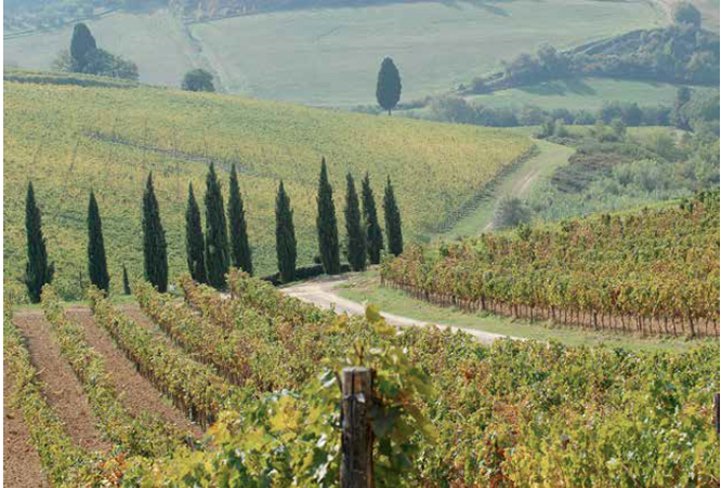
Photo credit: Consorzio Vino Chianti
Chianti is a diverse area that is mainly hilly, giving the vineyards very varied levels of exposure. The hills block the warm air that comes from the Mediterranean to the west, making the area a little cooler than the coast. The altitude varies but tends to make for cooler nights, allowing the grapes to ripen slowly. Many areas in Chianti have dry, rocky soils based on crumbly sandstone, slate or sand.
Chianti has seven sub-regions (Colli Aretini, Colli Fiorentini, Colli Senesi, Colline Pisane, Montalbano, Rufina and Montespertoli), whose names can be included on the label. The best-known of these are Chianti Rufina and Chianti Colli Senesi. The rules for the sub-regions are mainly the same but the maximum yields are slightly lower and the minimum alcohol content slightly higher.
Chianti Rufina is among the better known, as well as the smallest of the seven sub-regions. According to the Consorzio for Chianti Rufina, the 750 hectares (soon to be 1,000 hectares) of registered vineyards are divided between 120 grape growers, while there are 25 producers, including a cantina sociale, or co-op making the wine. The vineyards are high up the slopes of the Apennine foothills at between 200 and 700 metres. These relatively high altitudes and the pass in the mountains that allows cooling sea breezes to reach to vineyards result in slower ripening and higher acidity in the final wines, which also enables them to age for longer. Of course, as everywhere, the actual wine quality and characteristics vary from one producer to another and from one year to another.
Within Chianti, a smaller area has been defined, called Chianti Classico, and currently, there are around 7,500 hectares of vineyards on the Chianti Classico DOCG register. The Chianti Classico area consists of higher altitude vineyards with poor soil and slightly cooler conditions.
Within Chianti Classico, there is now a new classification called Gran Selezione for selected wines considered to be of very high quality made only with estate-grown grapes from the best vineyards and which have longer oak-ageing. These wines only earn the Gran Selezione title subject to tasting by a committee.
And, if all those names haven’t left you reeling, most appellations also have a “Riserva”, e.g. Chianti Classico Riserva or Chianti Rufina Riserva. These tend to have more or less the same rules as the non-Riserva wines but slightly more ageing requirement. For instance, Chianti Classico must be aged for at least 12 months but a Chianti Classico Riserva must have a minimum of 24 months’ ageing.
So just what is Chianti wine anyway?
Whether they are Classico, Gran Selezione, Rufina or just plain Chianti, all wines with “Chianti” on their label are made from between 70% and 100% Sangiovese, with other varieties accounting for a maximum of 30% of the blend for Chianti or 20% for Classico or Gran Selezione. In the case of Chianti, these varieties can include up to 10% white varieties – most notably the neutral and rather uninteresting Trebbiano Toscana (Ugni Blanc). Other permitted varieties are international varieties (often planted in the Maremma coastal area), such as Cabernet Sauvignon or Merlot, or indigenous red varieties like Canaiolo. Classico and Gran Selezione wines can have up to 20% other varieties added, but these do not include white varieties. (See our handy guide below for the differences between all the different wines.)
The trend is to make wines that have the maximum amount of Sangiovese and to use blending partners like Canaiolo that do not overwhelm the Sangiovese, which can occur with Cabernet Sauvignon, for instance.
In the past, many Chianti wines were thin and tart but gluggable. Such wines are less common these days as many producers have been working hard to improve quality, for instance replanting their vineyards with better quality Sangiovese clones and reducing yields.
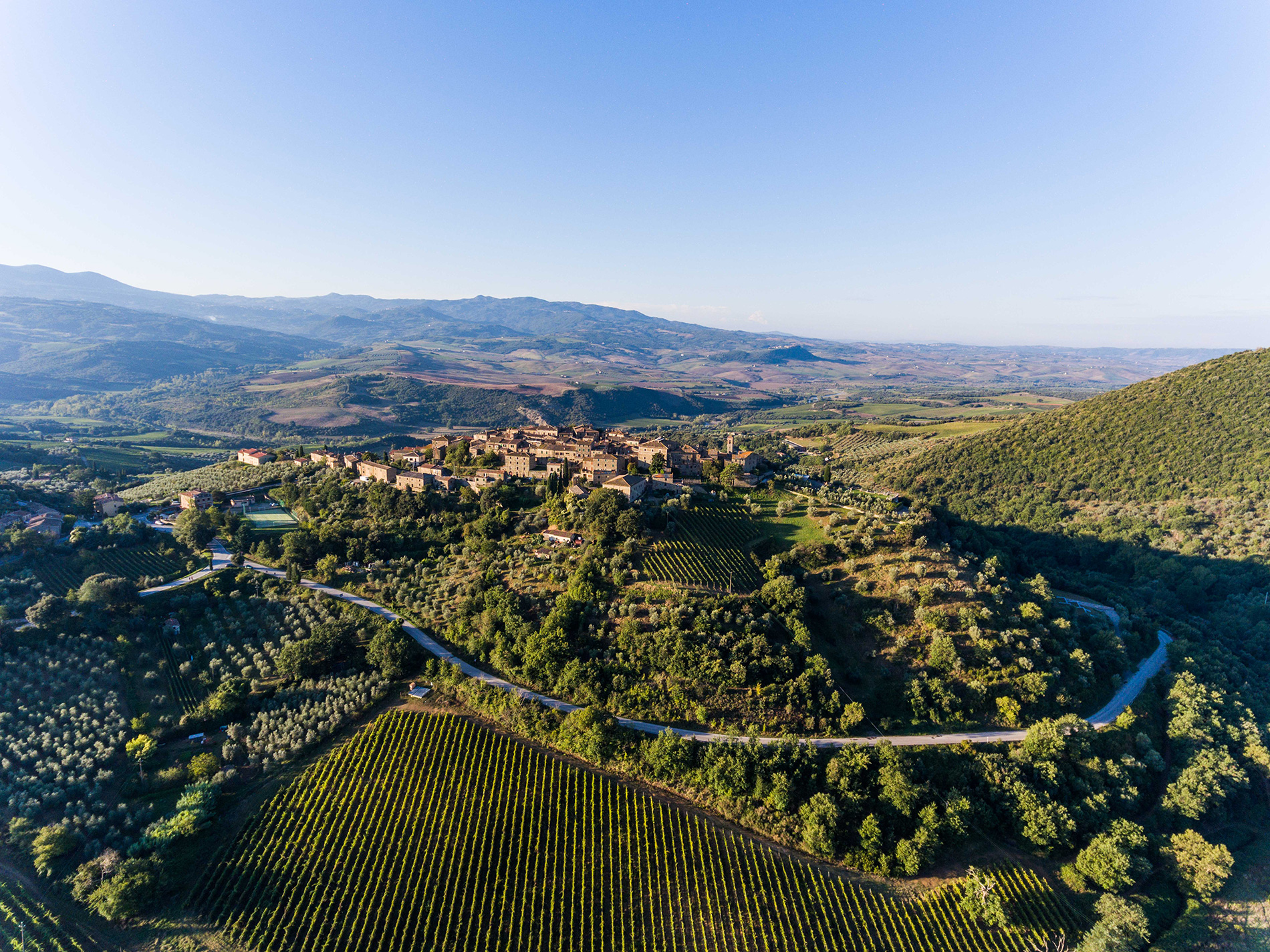
Photo credit: Consorzio del vino Brunello di Montalcino
Brunello di Montalcino
Brunello is made in the region surrounding the hilltop town of Montalcino, 40km to the south of the city of Siena. Just a few decades ago, this was a very poor region which had a small number of vineyards planted to Sangiovese (known as Brunello) and made a pale-coloured wine that took many years to be ready to drink. The story of how Brunello rose from obscurity to become one of the world’s most celebrated wines today is fascinating and has been well chronicled in Kerin O’Keefe’s book Brunello di Montalcino: Understanding and appreciating one of Italy’s greatest wines.
The area has great climatic and soil conditions for producing top-quality wines from Sangiovese. It has the pleasant Mediterranean climate of the Tuscan coast just 40km to the west but is protected from stormy weather coming in from the south-west by Monte Amiata to the south. The vineyards are situated at an altitude ranging from 120-650 metres above sea level – the higher altitude sites make for slower ripening, which helps with acidity retention and the development of aromas and flavours. The best vineyards are also planted on rockier, less fertile soils – some with marl and limestone content – similar to those found in the cooler Chianti Classico area.
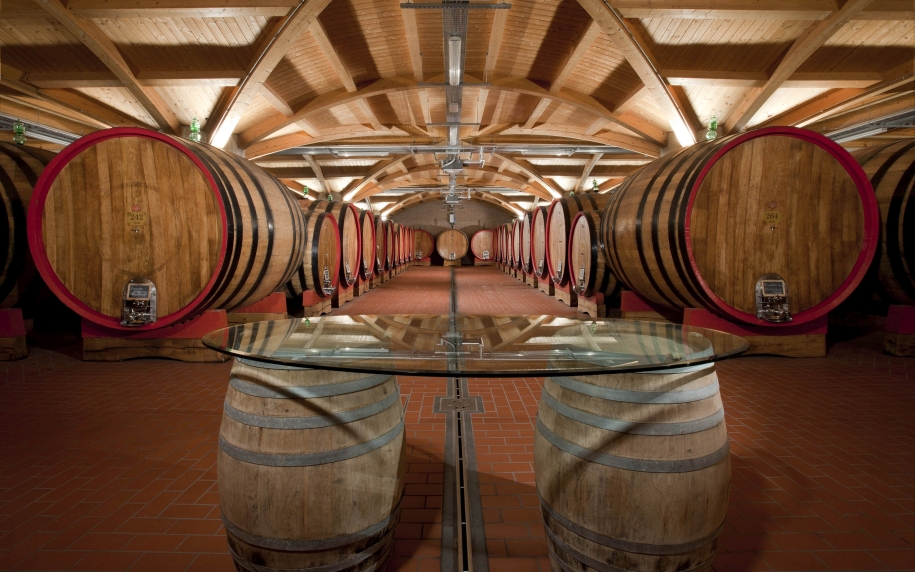
Cantina di Montalcino
Other wines from Montalcino
Rosso di Montalcino DOC is a lighter, easy-drinking Sangiovese wine with a minimum of one year’s ageing and a minimum alcohol content of 12% ABV.
The Sant’Antimo DOC was set up for wines made from other varieties. Sant’Antimo Rosso and Sant’Antimo Bianco can be made from any grape variety permitted in Tuscany. The red wines can be labelled with the varieties Cabernet Sauvignon, Merlot or Pinot Noir (Pinot Nero), while the whites can be labelled Chardonnay, Sauvignon Blanc or Pinot Grigio. The Tuscan sweet wine Vin Santo can also be produced under the DOC Sant’Antimo (more about that below).
Vino Nobile di Montepulciano
Montepulciano DOCG is located to the east of Montalcino and there is an area of Chianti in between them. It does not benefit from the protection from storms and rain that Monte Amiata gives to Montalcino, so rainfall is higher (740mm a year). Vineyards are planted in clay and limestone at altitudes ranging from 250 to 580m.
Again, the wines can be 70% to 100% Sangiovese, with the international varieties being permitted in the blend. The wines must have at least two years’ ageing, with at least a year of that in oak.
As elsewhere in this region, there are contrasting styles of wine now being produced in Montepulciano. The first is a more modern approach, where Merlot or Syrah is added to the blend and the wine is aged in new French oak. This makes for wines with deeper colour, additional aromas like black plums, as well as the vanilla and toast notes from the oak. These techniques mean the wine is ready to drink younger. The other style is more traditional, where the wine is 100% Sangiovese or has local varieties like Canaiolo added and it undergoes longer ageing in the traditional large casks called botti.
Vino Nobile di Montepulciano Riserva must be aged 3 years (with a minimum of one year in oak). They tend to benefit from longer ageing before drinking.
Like Montalcino, the Montepulciano appellation also includes a Rosso and a Vin Santo.
Rosso di Montepulciano is an earlier-drinking, softer wine.
Carmignano
Carmignano is another Sangiovese stronghold. This is a lower-altitude area in the hills near Florence, so the wines can have lower acidity and softer tannins than Chianti Classico but these are bolstered by up to 20% Cabernet Sauvignon, which must be part of the blend. Carmignano’s Cabernet Sauvignon plantings actually predate those in Bolgheri and it is claimed that Cabernet Sauvignon in the area dates back to the Medicis. Up to 10% of the blend can be white varieties but not many do actually use them.
The wine must be aged for at least 12 months in oak or chestnut casks and many producers are now eschewing French barriques in favour of the traditional botti (large neutral oak casks).
Maremma Toscana
Maremma Toscana DOC is a large area of coastal Tuscany that acts as a catchall appellation for all the DOCs and DOCGs in this area from Lazio to Montalcino, as well as coastal appellations to the west. It includes Bolgheri, Livorno, Val di Cornia etc. Most of these areas are very new and have plantings of international varieties and Sangiovese. This is among Italy’s most rapidly changing wine regions and was where the whole Super Tuscan hubbub took place in the 1970s that was to have such a revolutionary effect on the Italian wine scene.
The story really began in the 1940s when Marchese Mario Incisa della Rocchetta – a fan of Bordeaux wines – planted some Cabernet Sauvignon vines in a rocky area of his wife’s San Guido estate to make wine for pleasure. In the 1960s, his nephews from the famous Tuscan wine family Antinori tried the wine and liked it so much, they decided to launch it on the market. They bottled it and sold it under the name Sassicaia, with spectacular results. In fact, Sassicaia is now among the world’s iconic Cabernet Sauvignon blends and is an appellation in its own right: DOC Bolgheri Sassicaia. The rules are that the wines must contain a minimum of 80% Cabernet Sauvignon – Merlot and Sangiovese are common blending partners. The wine has to be aged at least two years calculated from the 1 January of the year following the harvest, of which at least 18 months must be in 225-litre barriques.
(See our interview with Piero Incisa dell Rocchetta in Argentina’s Río Negro)
For the Antinori family, Sassicaia was just the start and their next step was to launch first a Sangiovese with a little Cabernet Sauvignon and then a Cabernet Sauvignon with a little Sangiovese in the mid-1970s. Many other producers followed suit. These wines had to be labelled Vino di Tavola at that time (what today would be labelled IGT) but were hugely successful, sometimes selling at far higher prices than the Tuscan wines that did meet the appellation rules.
Bolgheri
Bolgheri DOC and Bolgheri Superiore DOC are either monovarietal wines or blends made from Cabernet Sauvignon, Merlot and/or Cabernet Franc with up to 50% Syrah and/or Sangiovese and less than 30% complementary varieties like Petit Verdot. Bolgheri can be released for sale after 1 September of the year following harvest, while Bolgheri Superiore must be aged for two years from the 1 January following harvest, one year of which must be in oak. The maximum yields are also slightly lower for Superiore wines.
San Gimignano
This is a hilly area surrounding the very pretty, historic town of San Gimignano in the north-western part of the province of Siena in Tuscany. It is home to its very own white variety – Vernaccia di San Gimignano – which experts believe is unrelated to the other grapes that are known as Vernaccia. It makes good-quality dry white wines. The wine must be made with at least 85% Vernaccia di San Gimignano. Up to 15% of other non-aromatic white grape varieties can be added. Sauvignon Blanc and Riesling may be included for a maximum (either alone or together) of 10%.
The best grapes selected are used to make Vernaccia di San Gimignano Riserva, which must undergo at least 11 months’ ageing (in stainless steel or wood) plus at least 3 months of bottle-ageing before release for sale. The maximum per-hectare yield is 9,000 kg. The grapes must be vinified and the wine aged within the production area.
Vernaccia di San Gimignano became trendy during the late twentieth century but, as often happens with white wine hits, producers were tempted to make “technical wines”, which tick all the right boxes but perhaps become a bit samey. These days, some producers are experimenting with barrel fermentation and orange wines.
The appellation also makes red, rosé and Vin Santo wines. The red and rosé wines must contain a minimum of 50% Sangiovese, along with up to a maximum 40% of Cabernet Sauvignon, Merlot, Syrah or Pinot Noir, either alone or in combination, and up to a maximum 15% of other non-aromatic red grape varieties. The following single-variety wines can be made and the variety specified on the label, so long as at least 85% of the wine consists of that variety: Sangiovese, Cabernet Sauvignon, Merlot, Syrah and Pinot Nero.
The main appellation is Vernaccia di San Gimignano DOCG, which is flanked by San Gimignano DOC. There are also vineyards in this area for the production of Chianti and Chianti Colli Senesi.
The IGTs
Producers who make wines that do not quite fit the appellation rules – this may be because of the grape variety(ies), style of wine or where the varieties are grown or simply because their wine wasn’t regarded as typical of the style when subject to a tasting committee – can label their wine under one of the IGTs (Indicazione Geografica Tipica). This might be Toscana IGT or, if they are located within certain smaller areas, by one of the other IGTs, like Maremma Toscana IGT.
It is a mistake to write these off as being lower quality than those wines labelled under more famous appellations, as they can be highly enjoyable wines that are individual or innovative in some way – you only have to look at the rise of the Super Tuscans back in the 1970s to realise that the wines that don’t quite fit the rules can sometimes be spectacular.
Wine pairings for Tuscan wine
Chianti will pair nicely with pasta or pizza, while the more complex Brunello or the more muscular Chianti Rufina will combine well with red meat or risotto. Try Vernaccia di San Gimignano with fish or salad. And, of course, Vin Santo is a delight at the end of the meal with dessert.
Annual production
According to the Italian National Institute of Statistics (ISTAT), in 2018 there were 53,662 hectares of productive vineyards and together they produced 2.7 million hectolitres of wine.
Useful resources on Tuscan wine
Consorzio del vino Brunello di Montalcino
Consorzio Vino Chianti Classico
The rules for Chianti production in English can be viewed here
Consorzio Vino Nobile de Montepulciano
Consorzio del Vino Vernaccia di San Gimignano
Robinson, J., and Harding, J. 2015. The Oxford Companion to Wine. 4th Ed. Oxford: Oxford University Press.
Clarke, O. and Rand, M., 2015, Grapes and Wines: A comprehensive guide to varieties and flavours. Pavilion Books Company Limited.
Johnson, H. and Robinson, J. 2013. The World Atlas of Wine. 7th Ed. Mitchell Beasley.
[/mepr-show]

